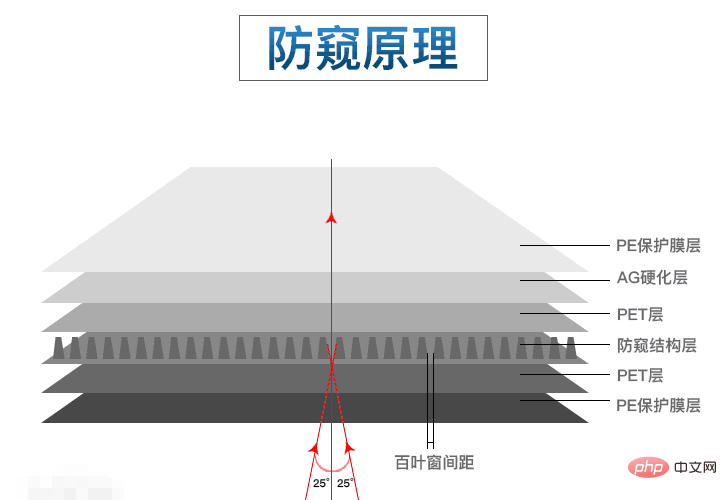Why can't fingerprints be used on the privacy film?
Reason: The anti-privacy film affects the transmission of light and has a certain reflection, causing abnormal sensor data and causing the light-sensitive fingerprint unlocking to not work properly. Screen fingerprint phones all use optical recognition. The fingerprint under the optical screen is actually recognized by the light reflected from the screen by the finger. The anti-privacy film not only weakens the screen light, but also reduces the light reflected by the finger onto the module.

The operating environment of this tutorial: HarmonyOS 2 system, HUAWEI P30 Pro mobile phone.
Anti-privacy film is one of the most popular mobile phone films now, which can protect your privacy. In public places, no one can see what you are doing with your phone, not even your friends, even when you are playing with your phone! The privacy film is so useful, but it is not very compatible with fingerprint recognition. The privacy film will cause the under-screen fingerprint recognition of some mobile phones to malfunction.
Why can’t the privacy film use fingerprints
The privacy film adopts the world’s unique ultra-fine blind optical patented technology to make the screen display The information is designed for users to read from the front. Anyone watching from the sides can only see a dark screen.
The anti-privacy film affects the transmission of light and has a certain degree of reflection, causing abnormal sensor data and causing the light-sensitive fingerprint unlocking to fail to work properly. Screen fingerprint phones all use optical recognition.
The fingerprint under the optical screen is actually recognized by the light reflected from the screen by the finger. The anti-privacy film not only weakens the screen light, but also reduces the light reflected by the finger onto the module.
Using the principle of light transmittance
The principle of anti-peep mobile phone film is achieved by using light transmittance and light refraction, the same as dark glass.
Affects light propagation
Affects light propagation, and has a certain reflection, causing abnormal sensor data.
Using optical recognition
As a result, light-sensitive fingerprint unlocking cannot be used normally. Screen fingerprint phones all use optical recognition.
Straight line transmission
The anti-peeping film allows light to travel in a straight line and blocks the transmission of light, unless it is customized.

Expand knowledge: Uses of privacy film
Mostly used on laptops. It is a semi-rigid film of plastic material covering the screen, about 1mm-2mm thick. The main function is to lower the display angle of the screen. Simply put, people around you will not be able to see the content of your screen clearly. This is where the name of privacy protection comes from. Mainly used for business notebooks. Since this type of notebook is used for work, using this can prevent someone from snooping on your secrets. Generally, many commercial notebooks will have this option. Since home notebooks are mainly used for entertainment, and manufacturers strive to expand the display range to enhance the sharing of screen content by multiple people, they generally do not have this option.
The existing privacy film products are composed of the original anti-reflective film, anti-UV film, mirror film, and anti-radiation film, and then add the new function of privacy film.
For more related knowledge, please visit the FAQ column!
The above is the detailed content of Why can't fingerprints be used on the privacy film?. For more information, please follow other related articles on the PHP Chinese website!

Hot AI Tools

Undresser.AI Undress
AI-powered app for creating realistic nude photos

AI Clothes Remover
Online AI tool for removing clothes from photos.

Undress AI Tool
Undress images for free

Clothoff.io
AI clothes remover

AI Hentai Generator
Generate AI Hentai for free.

Hot Article

Hot Tools

Notepad++7.3.1
Easy-to-use and free code editor

SublimeText3 Chinese version
Chinese version, very easy to use

Zend Studio 13.0.1
Powerful PHP integrated development environment

Dreamweaver CS6
Visual web development tools

SublimeText3 Mac version
God-level code editing software (SublimeText3)

Hot Topics
 1371
1371
 52
52
 Why can't fingerprints be used on privacy films?
Mar 27, 2023 am 11:12 AM
Why can't fingerprints be used on privacy films?
Mar 27, 2023 am 11:12 AM
The anti-privacy film cannot be used with fingerprints because the working principle of optical fingerprints under the screen is to obtain the light reflected by the user's fingerprint, and the design of the anti-privacy film will affect the penetration angle of light, resulting in the signal acquired by the final device. It becomes weak and the unlocking is not sensitive, so after applying the anti-privacy film, the in-screen fingerprint cannot be unlocked.
 Windows Hello not working on Windows 11? Try these 3 methods
Apr 15, 2023 pm 10:31 PM
Windows Hello not working on Windows 11? Try these 3 methods
Apr 15, 2023 pm 10:31 PM
Windows Hello is a biometric login mechanism that uses a near-infrared (IR) imaging camera or fingerprint sensor instead of a password to identify you. There have been reports of some people not being able to use the fingerprint sensor, so that element is worth considering as well. Additionally, the login mechanism is an alternative to passwords. It's a more user-friendly, reliable and secure option for accessing critical devices, services and data than traditional passwords. Windows Hello was launched in 2015 for Windows 10 and is intended to come to Windows 11. Why doesn't WindowsHello work on Windows 11? Most Windows 11
 What is the difference between capacitive, optical and ultrasonic fingerprints: understand in one article
Jul 18, 2024 pm 02:05 PM
What is the difference between capacitive, optical and ultrasonic fingerprints: understand in one article
Jul 18, 2024 pm 02:05 PM
Nowadays, fingerprint recognition technology has become an indispensable security feature of mobile phones. From the initial password input to sliding pattern unlocking to today's fingerprint recognition, the evolution of unlocking methods not only improves security, but also optimizes user experience. Currently, there are various fingerprint recognition technologies on the market, including ultra-thin under-screen fingerprint recognition, screen ultrasonic fingerprint, ultrasonic fingerprint unlocking, etc. These technologies sound high-end, but what’s the difference between them? Which one is the most practical? Let's talk together. Capacitive fingerprint recognition Capacitive fingerprint recognition technology collects fingerprints through two methods: scratching and pressing. Scratching technology is gradually being eliminated by the market due to its high operational requirements and low recognition speed and accuracy. With push-type capacitive fingerprint recognition technology, users only need to simply press to complete the process.
 Xiaomi Mi 15 will be standard on all series! Ultrasonic fingerprint science
Jun 29, 2024 am 03:04 AM
Xiaomi Mi 15 will be standard on all series! Ultrasonic fingerprint science
Jun 29, 2024 am 03:04 AM
There are currently two mainstream biometric unlocking methods for mobile phones: face recognition and fingerprint unlocking. Android generally chooses a wide variety of fingerprint unlocking: capacitive fingerprint unlocking, short-throw fingerprint unlocking, ultra-thin fingerprint unlocking and ultrasonic fingerprint unlocking. So what are the differences between these four types of fingerprint unlocking? What are the advantages and disadvantages of each? Optical fingerprint recognition uses light to capture an image of a fingerprint. A light source illuminates the finger, and then a camera captures the reflected light, creating an image of the fingerprint. There are two types of optical fingerprints: short-focus fingerprint unlocking and ultra-thin fingerprint unlocking. 1. Short-focus fingerprint unlocking Since short-focus fingerprints are thicker than ultra-thin fingerprints, in order to increase battery capacity, the fingerprints are usually placed lower on the phone, making unlocking with your thumb uncomfortable. Optical fingerprint unlocking Optical fingerprint unlocking
 Why can't fingerprints be used on the privacy film?
Mar 16, 2023 pm 05:29 PM
Why can't fingerprints be used on the privacy film?
Mar 16, 2023 pm 05:29 PM
Reason: The anti-privacy film affects the transmission of light and has certain reflections, causing abnormal sensor data and causing the light-sensitive fingerprint unlocking to fail to work properly. Screen fingerprint phones all use optical recognition. The fingerprint under the optical screen is actually recognized by the light reflected from the screen by the finger. The anti-privacy film not only weakens the screen light, but also reduces the light reflected by the finger onto the module.
 Huawei's self-developed ultrasonic fingerprint sensor Mate70 revealed, tentatively scheduled to be released in November
Jul 31, 2024 am 07:11 AM
Huawei's self-developed ultrasonic fingerprint sensor Mate70 revealed, tentatively scheduled to be released in November
Jul 31, 2024 am 07:11 AM
Voice | Xiaobai would like to ask everyone first, what unlocking solution are you using on your mobile phone now? As far as under-screen fingerprints are concerned, ultrasonic solutions have always been at the "top of the tower", with strict hierarchies, high costs, and rarely decentralized from flagships. Therefore, most of the mobile phones we see are equipped with optical under-screen fingerprints (some are ultra-thin). (short focus), but since the launch of the domestically produced Goodix ultrasonic under-screen fingerprint sensor, in addition to the two new blue-factory phones that have been released, most of the subsequent manufacturers’ new flagships have revealed that they will be equipped with it, so it should be gradually popularized in the future. Huawei has no relevant models yet and seems to be developing its own ultrasonic fingerprint solution. The picture above shows the ultrasonic fingerprint and short-focus optical under-screen fingerprint in the vivoX100 series. The solution comes from Goodix Technology. Recently, digital chat sites broke the news that Huawei
 Apple working on under-screen Touch ID, expected to debut in first full-screen iPhone
Apr 15, 2023 am 08:01 AM
Apple working on under-screen Touch ID, expected to debut in first full-screen iPhone
Apr 15, 2023 am 08:01 AM
Apple is continuing to work on under-screen fingerprint sensor technology for iPhones with a view to reintroducing TouchID in its first full-screen model. Apple's roadmap for TouchID on iPhone has been vague at best since FaceID debuted on 2017's iPhone It's no secret that Apple has been working on a TouchID system designed to sit beneath the display since at least 2013, and the company has been granted a number of patents over the years. However, despite claiming not to
 Can the battery also unlock mobile phone fingerprints? Is fingerprint unlocking really safe? Popular science!
Mar 25, 2024 am 09:40 AM
Can the battery also unlock mobile phone fingerprints? Is fingerprint unlocking really safe? Popular science!
Mar 25, 2024 am 09:40 AM
Two short videos talk about the fingerprint unlocking that everyone has been talking about recently ~ historical information



